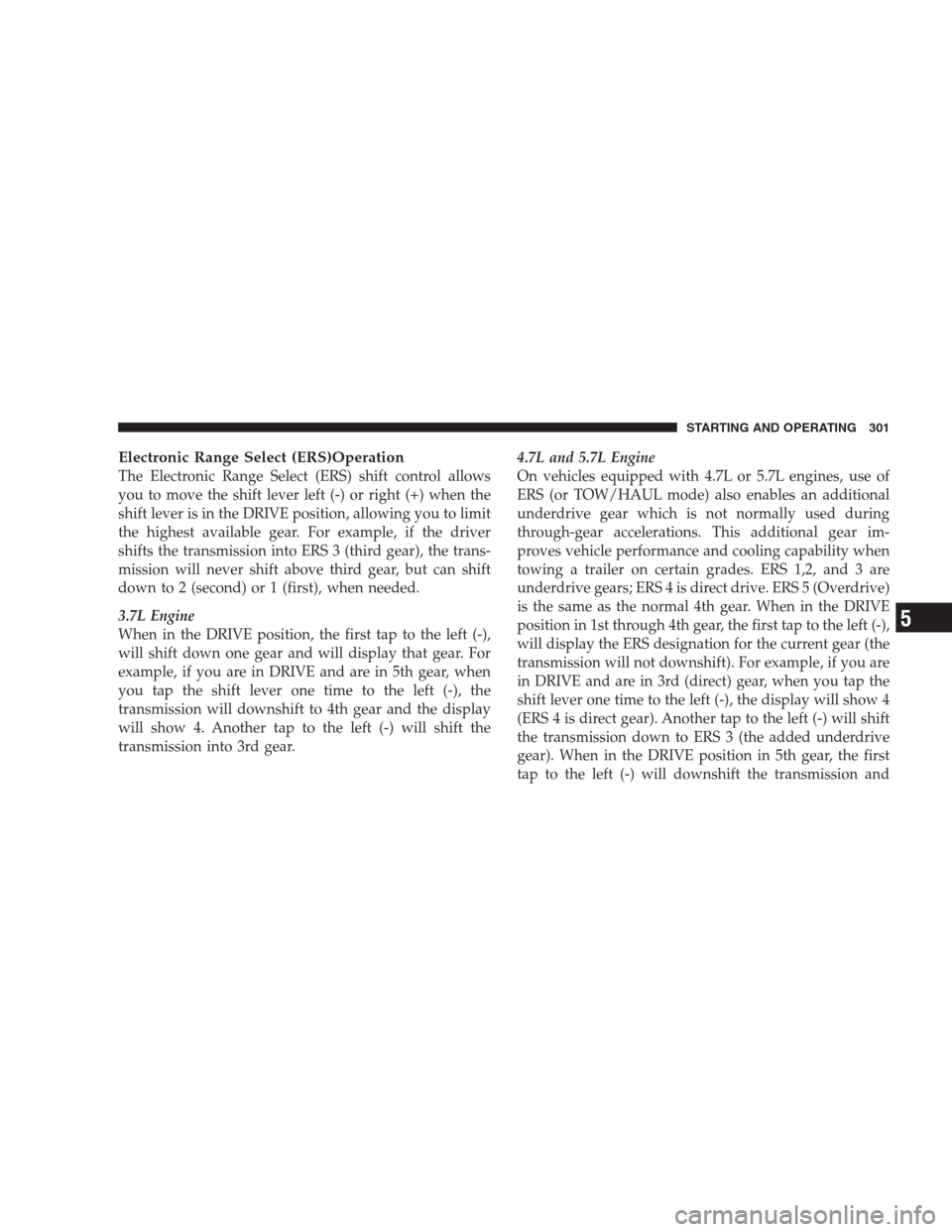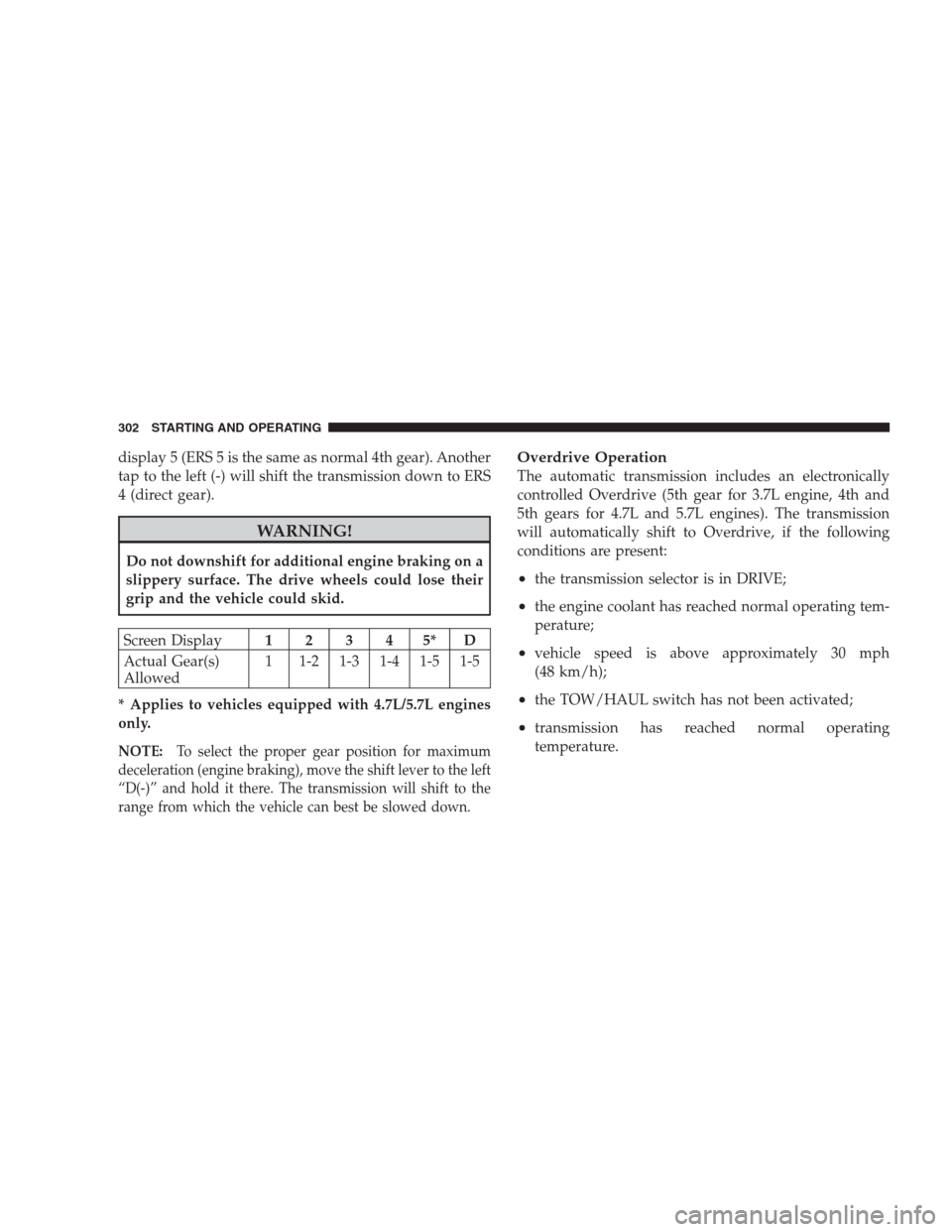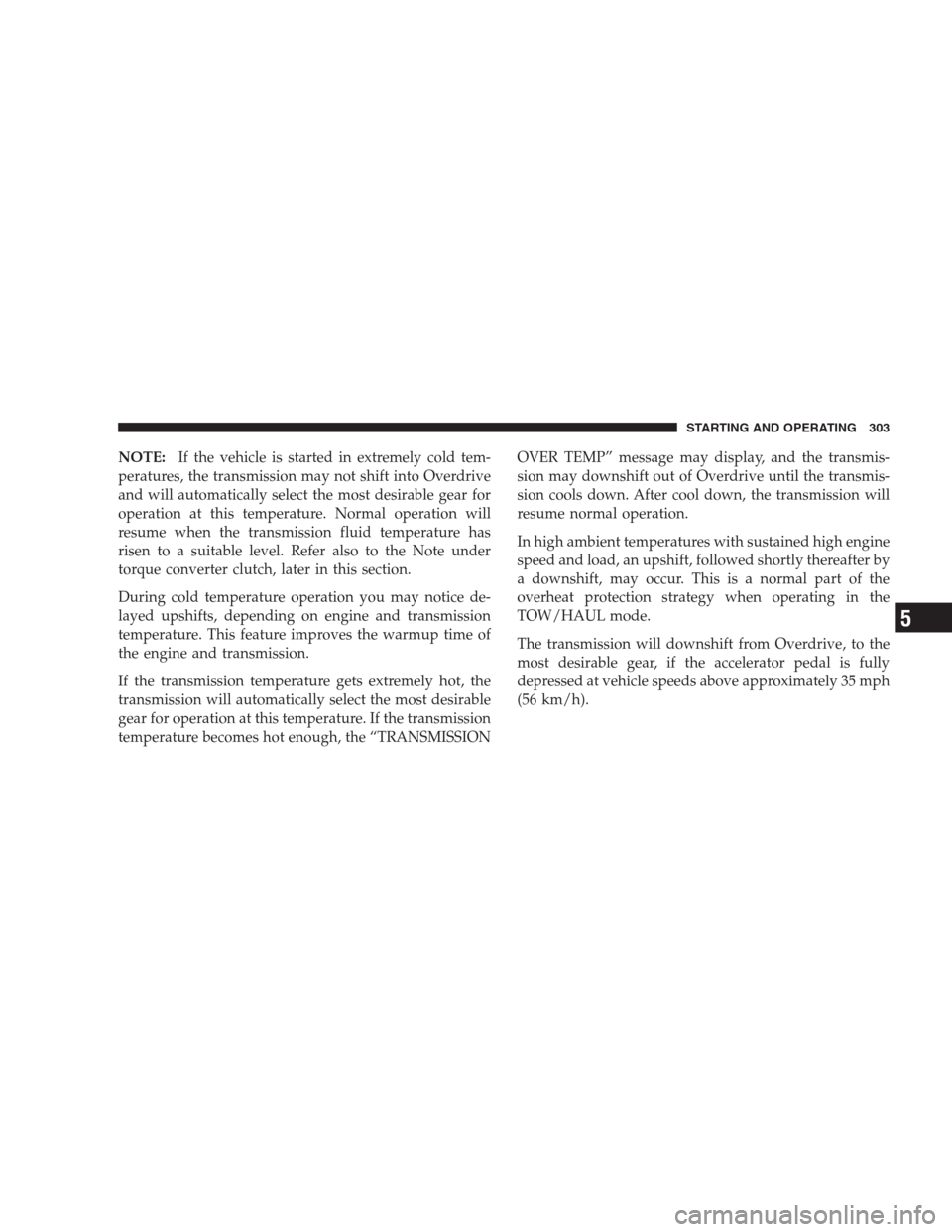Page 286 of 519

Regular cleaning of the inside of the windows with a
non-filming cleaning solution (vinegar and water works
very well) will help prevent contaminates (cigarette
smoke, perfumes, etc.) from sticking to the windows.
Contaminates increase the rate of window fogging.
Summer Operation
Air conditioned vehicles must be protected with a high
quality antifreeze coolant, during summer, to provide
proper corrosion protection and to raise the boiling point
of the coolant for protection against overheating. A 50%
concentration is recommended. Refer to Fluids, Lubri-
cants, and Genuine Parts in Section 7 for the proper
coolant type.
When using the air conditioner in extremely heavy traffic, in
hot weather, especially when towing a trailer, additional
engine cooling may be required. If this situation is encoun-
tered, operate the transmission in a lower gear to increase
engine RPM, coolant flow and fan speed. When stopped inheavy traffic, it may be necessary to shift into NEUTRAL
and depress the accelerator slightly for fast idle operation to
increase coolant flow and fan speed.
Your air conditioning system is also equipped with an
automatic recirculation system. When the system senses
a heavy load or high heat conditions, it may use partial
Recirculation A/C mode to provide additional comfort.
Winter Operation
When operating the system during the winter months, make
sure the air intake, located directly in front of the wind-
shield, is free of ice, slush, snow, or other obstructions.
Vacation Storage
Anytime you store your vehicle, or keep it out of service
(i.e. vacation) for two weeks or more, run the air condi-
tioning system at idle for about five minutes in the fresh
air and high blower setting. This will ensure adequate
system lubrication to minimize the possibility of com-
pressor damage when the system is started again.
284 UNDERSTANDING YOUR INSTRUMENT PANEL
Page 293 of 519
�Trailer Towing........................ 380
▫Common Towing Definitions............ 380
▫Trailer Hitch Classification.............. 383
▫Trailer Towing Weights (Maximum Trailer
Weight Ratings)...................... 384
▫Trailer And Tongue Weight.............. 385
▫Towing Requirements................. 386
▫Towing Tips........................ 391�Snow Plow.......................... 392
�Recreational Towing
(Behind Motorhome, Etc.)................. 392
▫Towing – 2WD Models................. 392
▫Towing — Quadra-Trac I�(Single-Speed
Transfer Case) 4WD Models............. 393
▫Towing — Quadra–Trac II�/Quadra–Drive
II�4WD Models..................... 393
STARTING AND OPERATING 291
5
Page 297 of 519

If Engine Fails To Start
WARNING!
•Never pour fuel or other flammable liquids into the
throttle body air inlet opening in an attempt to start
the vehicle. This could result in a flash fire causing
serious personal injury.
•Do not attempt to push or tow your vehicle to get it
started. Vehicles equipped with an automatic trans-
mission cannot be started this way. Unburned fuel
could enter the catalytic converter and once the
engine has started, ignite and damage the converter
and vehicle. If the vehicle has a discharged battery,
booster cables may be used to obtain a start from a
booster battery or the battery in another vehicle.
This type of start can be dangerous if done improp-
erly. Refer to Section 6 for proper jump-starting
procedures and follow them carefully.
Clearing A Flooded Engine - Using ENGINE
START/STOP Button
If the engine fails to start after you have followed the
“Normal Starting” or “Extreme Cold Weather�procedures, it
may be flooded. To clear any excess fuel, press and hold the
accelerator pedal all the way to the floor with your right
foot, and then press and release the ENGINE START/STOP
button once. The starter motor will engage automatically,
run for 10 seconds, and then disengage. Once this occurs,
release the accelerator pedal and the brake pedal, wait 10 to
15 seconds, then repeat the normal starting procedure.
Clearing A Flooded Engine - Using Fob With Integrated
Key
If the engine fails to start after you have followed the
“Normal Starting” or “Extreme Cold Weather” procedures,
it may be flooded. To clear any excess fuel, push the
accelerator pedal all the way to the floor and hold it. Then,
turn the ignition switch to the START position and release it
as soon as the starter engages. The starter motor will
disengage automatically in 10 seconds. Once this occurs,
STARTING AND OPERATING 295
5
Page 302 of 519

WARNING!
•Never use the PARK position as a substitute for
the parking brake. Always apply parking brake
fully when parked to guard against vehicle move-
ment and possible injury or damage.
•It is dangerous to move the shift lever out of PARK
or NEUTRAL if the engine speed is higher than
idle speed. If your foot is not firmly on the brake
pedal, the vehicle could accelerate quickly forward
or in reverse. You could lose control of the vehicle
and hit someone or something. Only shift into
gear when the engine is idling normally and when
your right foot is firmly on the brake pedal.
REVERSE
Use this range only after the vehicle has come to a
complete stop.
NEUTRAL
Shift into NEUTRAL when the vehicle is standing for
prolonged periods with the engine running. The engine
may be started in this range. Set the parking brake if you
must leave the vehicle.
NOTE:Towing the vehicle, coasting, or driving for any
other reason with the shift lever in NEUTRAL can result
in severe transmission damage. Refer to “Recreational
Towing” in Section 5 and “Towing a Disabled Vehicle” in
Section 6 of this manual.
DRIVE
Shift into DRIVE only when the vehicle is at a complete
stop and the brakes are firmly applied. The transmission
automatically upshifts through fifth gear. The DRIVE
position provides optimum driving characteristics under
all normal operating conditions.
300 STARTING AND OPERATING
Page 303 of 519

Electronic Range Select (ERS)Operation
The Electronic Range Select (ERS) shift control allows
you to move the shift lever left (-) or right (+) when the
shift lever is in the DRIVE position, allowing you to limit
the highest available gear. For example, if the driver
shifts the transmission into ERS 3 (third gear), the trans-
mission will never shift above third gear, but can shift
down to 2 (second) or 1 (first), when needed.
3.7L Engine
When in the DRIVE position, the first tap to the left (-),
will shift down one gear and will display that gear. For
example, if you are in DRIVE and are in 5th gear, when
you tap the shift lever one time to the left (-), the
transmission will downshift to 4th gear and the display
will show 4. Another tap to the left (-) will shift the
transmission into 3rd gear.4.7L and 5.7L Engine
On vehicles equipped with 4.7L or 5.7L engines, use of
ERS (or TOW/HAUL mode) also enables an additional
underdrive gear which is not normally used during
through-gear accelerations. This additional gear im-
proves vehicle performance and cooling capability when
towing a trailer on certain grades. ERS 1,2, and 3 are
underdrive gears; ERS 4 is direct drive. ERS 5 (Overdrive)
is the same as the normal 4th gear. When in the DRIVE
position in 1st through 4th gear, the first tap to the left (-),
will display the ERS designation for the current gear (the
transmission will not downshift). For example, if you are
in DRIVE and are in 3rd (direct) gear, when you tap the
shift lever one time to the left (-), the display will show 4
(ERS 4 is direct gear). Another tap to the left (-) will shift
the transmission down to ERS 3 (the added underdrive
gear). When in the DRIVE position in 5th gear, the first
tap to the left (-) will downshift the transmission and
STARTING AND OPERATING 301
5
Page 304 of 519

display 5 (ERS 5 is the same as normal 4th gear). Another
tap to the left (-) will shift the transmission down to ERS
4 (direct gear).
WARNING!
Do not downshift for additional engine braking on a
slippery surface. The drive wheels could lose their
grip and the vehicle could skid.
Screen Display12345*D
Actual Gear(s)
Allowed1 1-2 1-3 1-4 1-5 1-5
* Applies to vehicles equipped with 4.7L/5.7L engines
only.
NOTE:To select the proper gear position for maximum
deceleration (engine braking), move the shift lever to the left
“D(-)” and hold it there. The transmission will shift to the
range from which the vehicle can best be slowed down.
Overdrive Operation
The automatic transmission includes an electronically
controlled Overdrive (5th gear for 3.7L engine, 4th and
5th gears for 4.7L and 5.7L engines). The transmission
will automatically shift to Overdrive, if the following
conditions are present:
•the transmission selector is in DRIVE;
•the engine coolant has reached normal operating tem-
perature;
•vehicle speed is above approximately 30 mph
(48 km/h);
•the TOW/HAUL switch has not been activated;
•transmission has reached normal operating
temperature.
302 STARTING AND OPERATING
Page 305 of 519

NOTE:If the vehicle is started in extremely cold tem-
peratures, the transmission may not shift into Overdrive
and will automatically select the most desirable gear for
operation at this temperature. Normal operation will
resume when the transmission fluid temperature has
risen to a suitable level. Refer also to the Note under
torque converter clutch, later in this section.
During cold temperature operation you may notice de-
layed upshifts, depending on engine and transmission
temperature. This feature improves the warmup time of
the engine and transmission.
If the transmission temperature gets extremely hot, the
transmission will automatically select the most desirable
gear for operation at this temperature. If the transmission
temperature becomes hot enough, the “TRANSMISSIONOVER TEMP” message may display, and the transmis-
sion may downshift out of Overdrive until the transmis-
sion cools down. After cool down, the transmission will
resume normal operation.
In high ambient temperatures with sustained high engine
speed and load, an upshift, followed shortly thereafter by
a downshift, may occur. This is a normal part of the
overheat protection strategy when operating in the
TOW/HAUL mode.
The transmission will downshift from Overdrive, to the
most desirable gear, if the accelerator pedal is fully
depressed at vehicle speeds above approximately 35 mph
(56 km/h).
STARTING AND OPERATING 303
5
Page 306 of 519
When To Use TOW/HAUL Mode — If Equipped
When driving in hilly areas, towing a trailer, carrying a
heavy load, etc., and frequent transmission shifting oc-
curs, press the TOW/HAUL switch. This will improve
performance and reduce the potential for transmission
overheating or failure due to excessive shifting. When
operating in TOW/HAUL mode, the transmission will
shift into direct gear and Overdrive will be enabled
under steady cruise conditions.
The “TOW/HAUL” indicator light will illuminate in the
instrument cluster to indicate when the switch has been
activated. Pressing the switch a second time restores
normal operation. If the TOW/HAUL mode is desired,
the switch must be pressed each time the engine is
started.
TOW/HAUL Switch
304 STARTING AND OPERATING